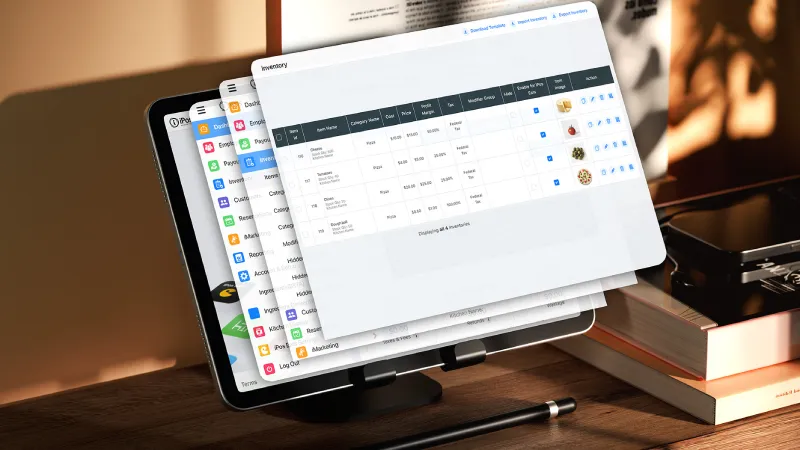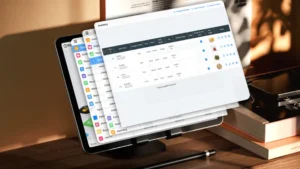Managing a restaurant is a frenzy, particularly during busy seasons. More customers mean more sales, but it also means more employees to handle the increased workload. This is where having an efficient payroll and team management system comes in.
Since you need to track employee hours accurately, ensure timely payments, and keep communication flowing smoothly, automatic and sync systems simplify the time-consuming tasks of restaurant staff management. In today’s restaurant industry, technologies have emerged as the lifesaving for owners and managers. Restaurant staff management is not exempt from this reality.
Payroll and team management softwares are now integrated into your POS System. This seamless integration with your existing sales can be a game-changer, reducing stress and errors while rewarding your staff fairly.
Here’s what we’ll cover in this post:
- The challenges of managing restaurant staff during busy seasons
- How does a payroll and team management system work?
- How integrated payroll and team management systems in your POS streamline your operations?
Ready to learn how staffing management software can transform your restaurant? Keep reading!
Why Optimize Staff Management in your Restaurant?
The restaurant industry is booming, with projections for 200,000 new jobs by 2024. In full-service restaurants alone, the average workforce ranges between 10-40 employees per shift. For front of the house (FOH – Service/servers), the standard is one staff member per shift for every 4 tables, while for back of the house (BOH – Kitchen/cook staff), the typical ratio is 6 staff members per shift for 50–60 restaurant covers.
Adding to the complexity is high staff turnover, which averaged 28% in 2024 for full-service restaurants. This constant churn makes consistent operations and profitability challenging, particularly in terms of staff hiring and retention. Therefore, streamlining workflows, communication, training, and payroll systems is essential to create a more positive work environment and reduce turnover.
Benefits of Efficient Payroll and Team Management
A payroll and team management system can play a crucial role in reducing staff fluctuation in a restaurant. In essence, payroll systems ensure accurate and timely payments while adhering to financial regulations. In addittion, team management features handle employee timesheets, scheduling, and HR functions. Combining these features into one platform simplifies daily tasks. Imagine employee punches syncing directly to payroll, saving hours! Plus, you can manage vacation requests and approvals all within the same system.
- Efficient Payroll Management: A well-structured payroll system ensures that employees are paid accurately and on time, which can significantly boost their morale and job satisfaction.
- Employee Self-Service: Many payroll systems provide self-service portals where employees can access their pay stubs, tax information, and benefits details.
- Automated Scheduling: Team management systems often include scheduling features. It helps to distribute work hours fairly and efficiently, taking into account employee preferences and availability.
- Performance Tracking: These systems can also track employee performance, helping managers to recognize and reward hard work, which can improve employee retention.
- Centralized Information: Having a single source of truth for your payroll processes and best practices ensures your entire payroll department is working with the same standards in mind.
- Reduced Errors: Automated payroll and team management systems can reduce the likelihood of errors in payroll processing, which can lead to employee dissatisfaction and turnover.
By integrating payroll and team management, you gain a comprehensive solution for effective HR management. Not only will your employees get paid accurately and on time, but you’ll also enjoy simplified scheduling, tracking, and overall team management.
How does integrated Payroll and Team Management System in your POS works?
In modern POS Systems, team management and payroll are integrated as a feauture. It’s like having an HR manager, a sales tracker, and an accountant all rolled into one! But, how does a POS system exactly manage your restaurant staff?
- Employee ID Creation: The POS software automatically generates a unique ID for a new employee added to the system, serving as their digital identifier within the system.
- Employee Login: Each time an employee starts their shift, they log into the POS system using their unique ID.
- Activity Tracking: Once logged in, the POS system tracks all activities associated with that employee ID. This includes sales transactions, customer interactions, and other tasks performed on the POS system.
- Time Tracking: The POS system also records the time the employee logs in and out, providing a record of the hours worked. This is crucial for payroll calculations.
- Sales Attribution: The system attributes all sales transactions the employee conducts while logged in to their ID, enabling tracking of individual employee performance and potential commission calculations.
- Reporting: The POS system generates reports based on the activity associated with each employee ID, providing insights into employee performance, sales trends, and more.
- Tax and Deductions: The system can also calculate and deduct taxes based on the employee’s location and other factors such as health insurance or retirement contributions.
- Payroll Processing: Once the system calculates everything, it can process the payroll, which may involve direct deposit into the employee’s bank account or generating a check or cash payment.
In this way, the POS system provides a comprehensive solution for tracking employee activities, calculating payroll, and generating valuable business insights. Overall, it’s a powerful tool for businesses of all sizes.
Employee Data Repporting within Payroll Management System

The team management and payroll features in a POS system integrates and automatically syncs all data related to employee work hours, sales transactions, and payroll calculations. This can serve multiple purposes:
- Performance Analysis: The data can aid in analyzing the performance of individual employees or the entire team. This facilitates the identification of top performers and areas for improvement.
- Sales Forecasting: By analyzing sales data, the system can help forecast future sales trends. This can assist in inventory management and staffing decisions.
- Payroll Accuracy: Accurate tracking of work hours ensures that payroll calculations are correct, reducing the risk of errors and disputes.
In summary, the integration of team management and payroll features in a POS system not only simplifies day-to-day operations but also provides valuable data for strategic decision-making.
Are Payroll and Team Management System cost-effective?
Yes, a POS solution that integrates team and payroll management, is indeed cost-effective in several ways. Lets see how:
- Reduced Labor Costs: Automated scheduling and time tracking can reduce the time managers spend on these tasks, freeing them up for other duties. This can lead to a reduction in labor costs.
- Increased Accuracy: Digital tracking of sales and work hours reduces the risk of human error, which can lead to costly mistakes in payroll and inventory management.
- Improved Productivity: With a POS system handling tasks such as scheduling and payroll, employees can focus more on customer service and other core business activities. This can lead to increased productivity and potentially higher sales.
- Reduced Training Costs: Having one integrated system for all tasks means there’s only one system for employees to learn. This can reduce training time and costs.
- Better Decision Making: The data collected by the POS system can provide valuable insights that help in decision making. This can lead to more effective strategies and cost savings in the long run.
- Compliance Savings: Accurate record-keeping can help ensure compliance with labor laws and tax regulations, potentially saving the business from costly fines and penalties.
While there is an upfront cost to implementing a comprehensive POS system, the potential savings and benefits in the long run can make it a cost-effective solution. It’s an investment that can pay off through increased efficiency, accuracy, and productivity.
iPos: All-in-one POS System for managing your restaurant staff
Run your business with an All-in-One POS.
Find out how.
iPos POS System offers a complete solution designed to bridge the technological gap in the food and beverage industry. It offers built-in operations integration across every process, from team management to inventory and sales. So you can focus on providing the best services, while your POS provides you with information. This enhances the efficiency you need with integrated techs solutions.
Do you want to make your restaurant operations simpler? See what can we offer! Get a demo today!








